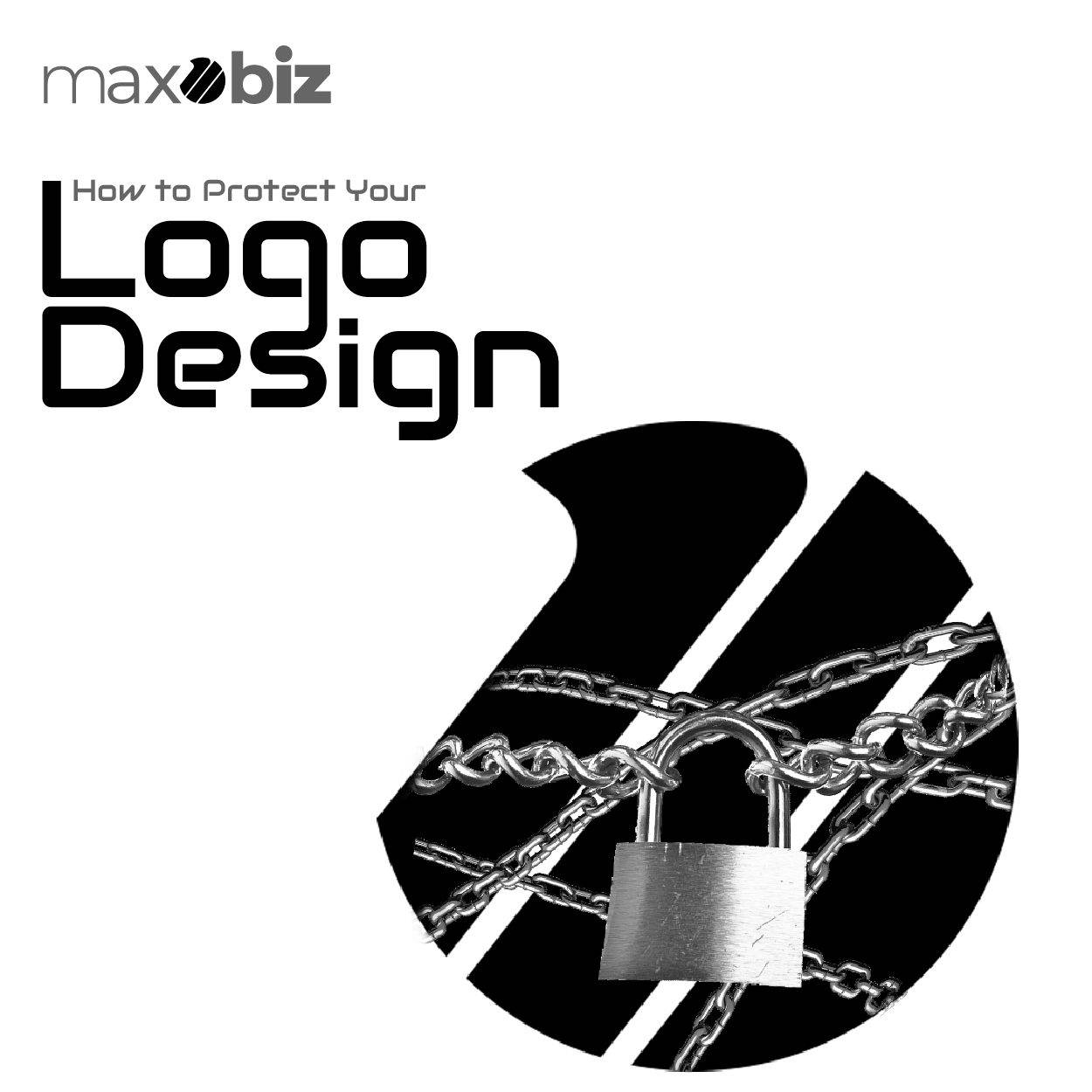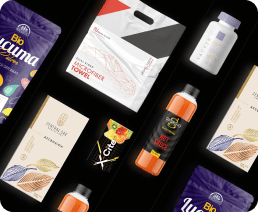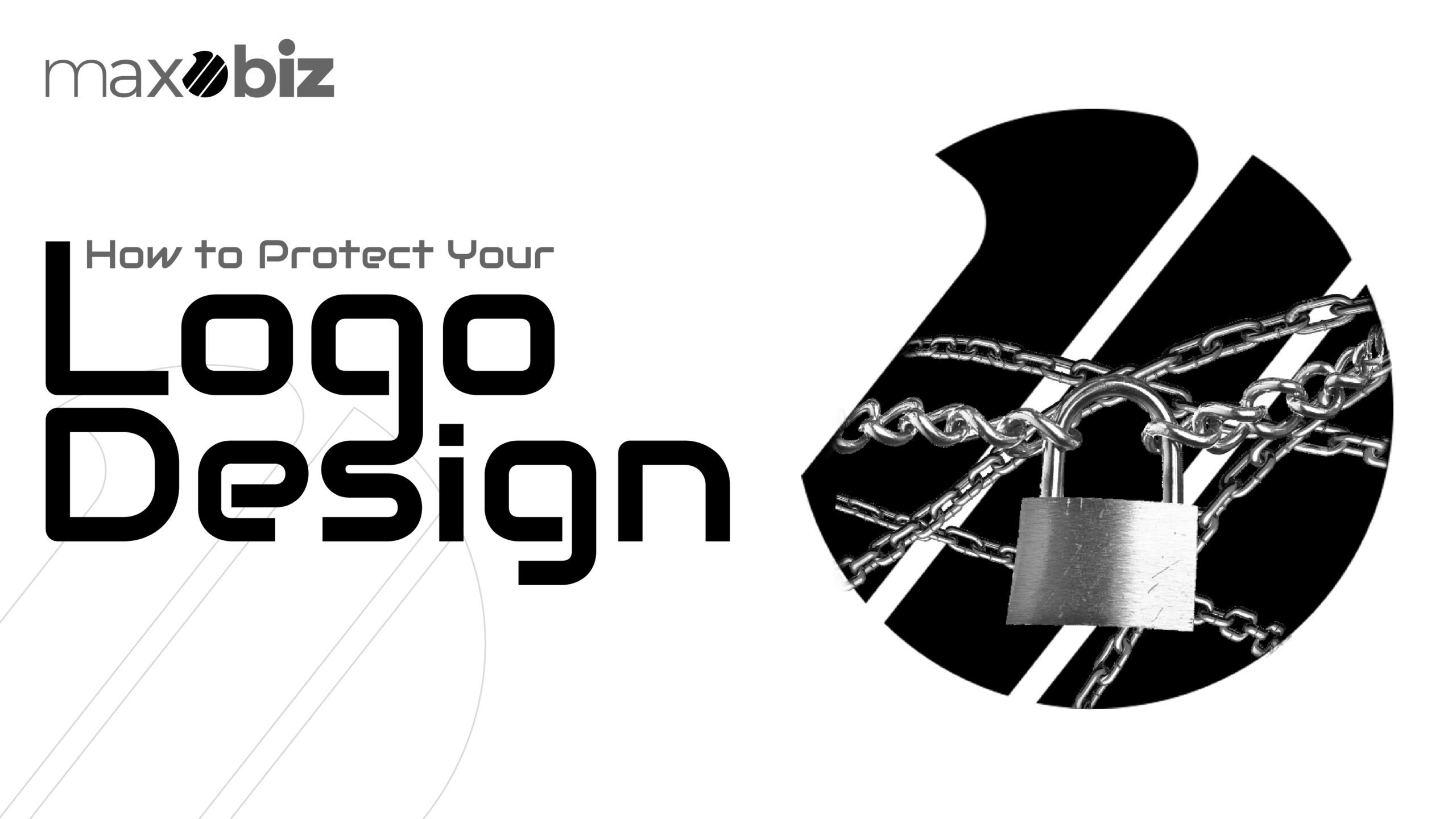Imagine you’ve just created this amazing logo. It’s unique, eye-catching, and perfectly captures the essence of your brand. You’re proud of it, right? But here’s the thing: in the bustling digital world, it’s super important to make sure your creative work stays safe and soundly yours. That’s where understanding intellectual property (IP) comes into play.
Understanding Intellectual Property in Logo Design
First off, what’s intellectual property? Think of it as the umbrella term for all the cool, creative stuff that comes from your brain – like inventions, literary works, and, of course, designs like your logo. It’s all about protecting the things you create from being used by others without your okay. Now, imagine your logo as your business’s face – it’s how people recognize you. Just like you wouldn’t want someone else using your identity, you don’t want another business using your logo. That’s where IP protection steps in, ensuring your logo stays uniquely yours.
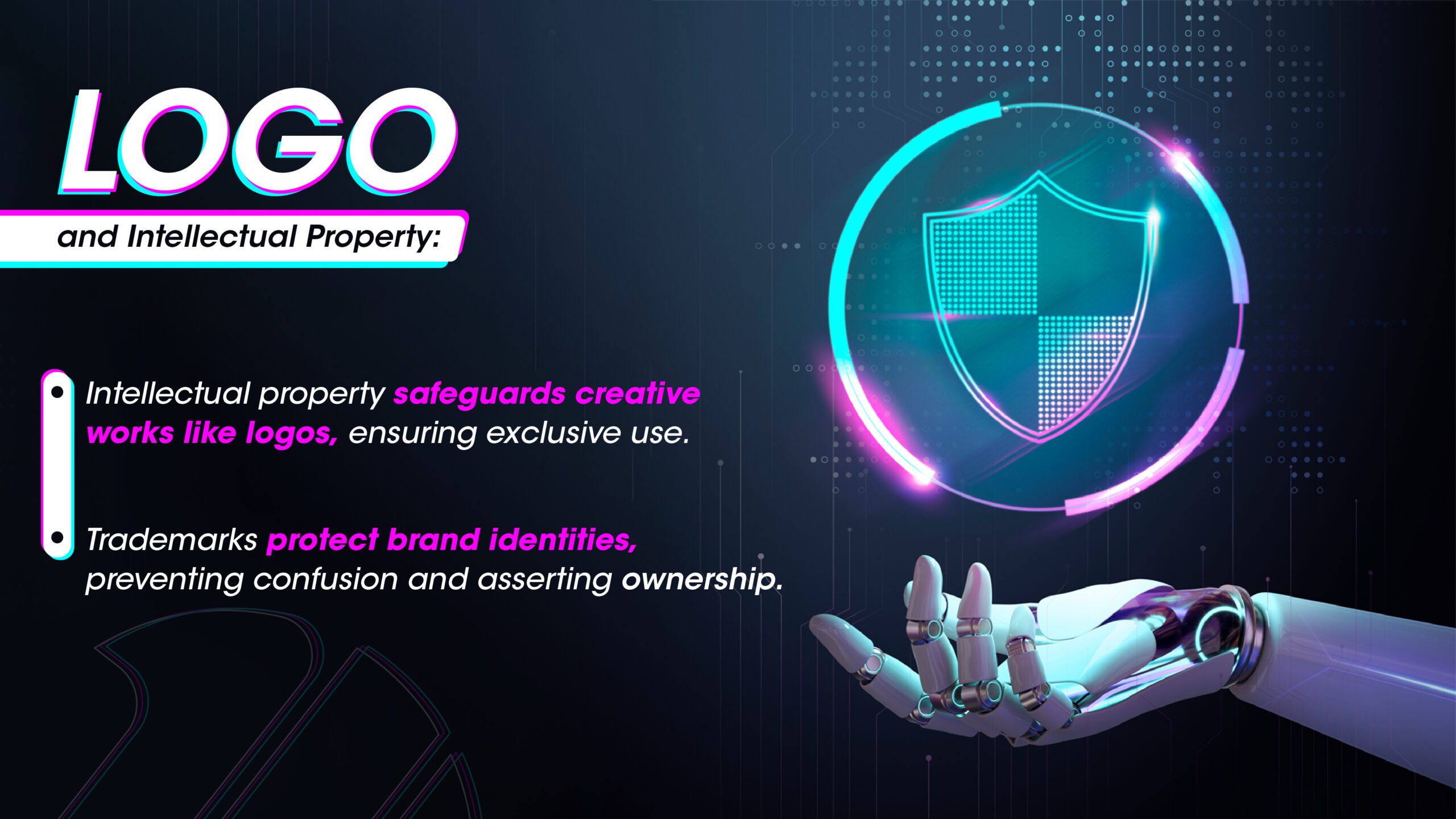
Trademark Basics
So, you’ve got this fantastic logo design. How do you protect it? Enter trademarks. A trademark is like a superhero shield for your brand’s identity. It legally protects brand names, slogans, and logos. When you trademark your logo, you’re telling the world, “Hey, this is mine, and only I get to use it for my business.” It’s a way of legally claiming ownership and preventing confusion in the market. Think about some famous logos you know – they’re trademarked so that no one else can use a similar design and make you think it’s them.
Trademark vs Copyright vs Patent
Now, this can get a bit confusing, so let’s simplify it. These three are like different flavours of IP protection, each with its purpose.
Trademark:
As we said, it’s all about protecting brand identifiers like logos, brand names, and slogans. It’s how you keep your brand’s image safe.
Copyright:
This one’s more for artistic works – think books, music, paintings, and even computer software. If you write a book or create a painting, copyright keeps others from copying or distributing your work without your permission.
Patent:
Have an invention or a unique product design? That’s where patents come in. They protect inventions, giving you the exclusive right to make, use, and sell your invention for a certain period.
The Path to Trademarking Your Logo
A Trademark is Like a Superpower for Your Logo: It’s a legal way to say, “This logo is mine!” Think of it as putting an invisible shield around your logo. No one can use it without your say-so.
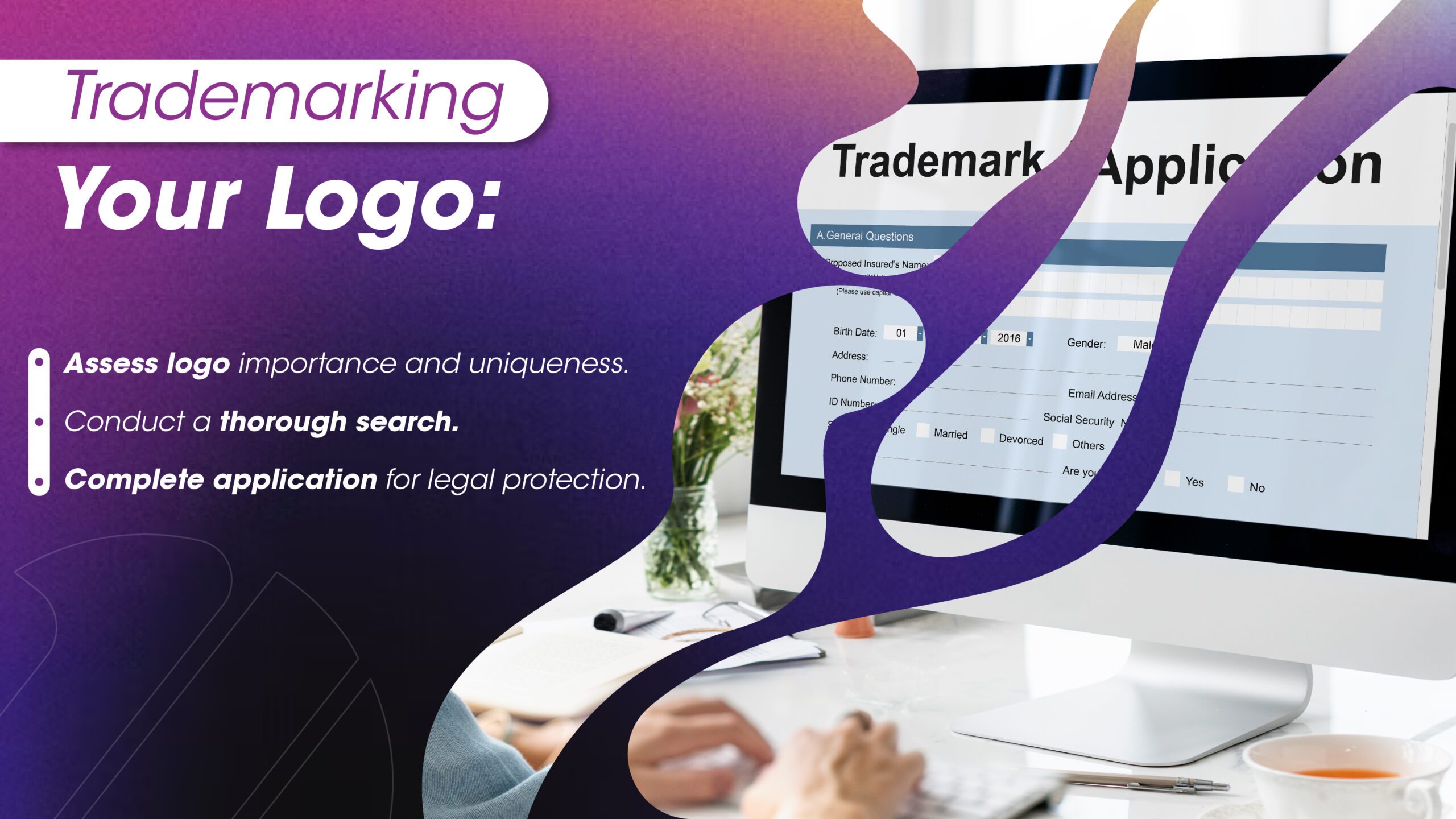
Evaluating the Need for a Trademark
Is it worth the Cape and Tights:
Do you need to trademark your logo? If your logo is crucial for your business, and you want to make sure no one else can use something similar, then yes! It’s like deciding if you need an umbrella on a cloudy day. Better safe than sorry.
Searching for Existing Trademarks
Playing Detective:
Before you can claim your logo, you have to make sure no one else has already claimed something similar. It’s like checking if someone else has already taken your awesome username idea. You can search online databases – it’s pretty easy and kinda fun, like a treasure hunt!
Detailed Steps to Trademark Application
Filling in the Blanks:
Ready to make your logo officially yours? Here’s how:
Create Your Masterpiece:
Make sure your logo is unique and represents your business.
Search High and Low:
Do a thorough search to ensure no one else has a similar trademark.
Gather Your Tools:
Prepare the necessary information and designs for your application.
Fill Out the Forms: :
Complete the trademark application. It’s a bit like doing your taxes but for your logo!
Wait for the Magic to Happen:
After submitting, there’s a waiting period. Use this time to dream about all the amazing things your business will do.
Receive Your Trademark:
Once approved, your logo is officially protected. Congratulations, you’re now a trademark superhero!
Types of Trademarks: Wordmarks and Design Marks
Let’s start with the basics. There are two main types of trademarks that you should know about wordmarks and design marks. These are like the peanut butter and jelly of the trademark world – both are awesome in their ways! Wordmarks are all about words, letters, or numbers. Think of them as the name of your brand. It’s like how you instantly recognize ‘Google’ or ‘Coca-Cola’ just by their names, right? That’s the power of a wordmark! Design Marks, on the other hand, are more like the stylish outfit your brand wears. These include logos, symbols, or any unique graphic design that identifies your brand without using words. Imagine the swoosh of Nike or the golden arches of McDonald’s. That’s the magic of design marks!
Defining Wordmarks and Design Marks
Now, let’s get a bit more into the nitty-gritty. Wordmarks are the textual part of your branding. They’re unique fonts or typographic treatments of your brand’s name. Simple, but powerful! Design Marks are, well, more artsy. They can be anything from a cool graphic to a funky symbol. These are the visual elements that make your brand stand out in a crowd. It’s like wearing a bright red hat in a sea of blue ones!
Choosing the Right Type for Your Logo
So, how do you decide whether to go for a wordmark or a design mark for your logo? It’s like choosing between a chocolate chip cookie and a brownie – both are great, but it depends on your taste and needs. Wordmarks are great if you’ve got a unique name that you want to stick in people’s minds. They work like a charm if your brand name is catchy, easy to remember, and you want to make a statement with just text.Design Marks are your go-to if you want something visually captivating that represents your brand without words.
This is perfect if your brand has a global presence and you want something that’s universally understood, no matter the language. In the end, choosing between a wordmark and a design mark for your logo is like picking the perfect outfit for a party. You want something that not only looks good but also tells a story about who you are. Now, don’t you think it’s amazing how much thought goes into a logo? It’s not just a pretty design; it’s a symbol of your brand’s personality
The Legal Powers of a Trademark
First up, what’s a trademark, you ask? It’s like a unique sign that helps you recognize a product or service – think of the golden arches of McDonald’s or Nike’s swoosh. These aren’t just cool designs; they’re trademarks that legally belong to their companies.
Protection and Enforcement
Now, for the superhero powers! Once a trademark is registered, it’s like having an invisible shield around it. This shield does a couple of super cool things:
Brand Identity:
Just like your name is uniquely yours, a trademark makes sure the brand stands out. No one else can use it without permission. It’s like saying, “Hey, this is mine, hands off!”
Legal Muscle:
If someone tries to use a similar mark and confuses customers, the trademark owner can swoop in with legal action. It’s like having a legal bodyguard that says, “Back off, buddy, this is protected!”
Monetary Value:
Trademarks can be valuable assets. Companies can license them out (kinda like renting your favourite video game to a friend), making some serious cash in the process.
Trademark Limitations and Exceptions
Trademarks usually protect a brand in specific countries or regions. So, a trademark in the US doesn’t automatically throw its shield around the brand globally.
Non-use:
If a trademark isn’t used for a long time, it might lose its powers. It’s like a muscle; if you don’t use it, you lose it.
Generic Terms:
Over time, some trademarks can become generic terms (like “escalator” once was a brand name!). When this happens, they might lose their special status.
Fair Use:
Sometimes, trademarks can be used without permission under “fair use.” This is usually for educational purposes, criticism, or parody – like in a comedy sketch.
Navigating Trademark Registration
Imagine you’ve created a super cool logo or a catchy phrase for your business. You love it so much that you want to make sure it’s uniquely yours. That’s where trademark registration comes in, like a superhero to protect your awesome creation!
Domestic and International Registration
First off, there are two playgrounds for trademark registration: domestic (in your own country) and international (around the globe). Let’s explore both:
Domestic Registration:
Think of this as protecting your trademark on your home turf. If you’re in the United States, for example, you’d register your trademark with the United States Patent and Trademark Office (USPTO). It’s like putting a big ‘No Trespassing’ sign on your property but for your brand!
International Registration:
Now, what if you want to protect your trademark in other countries? That’s where international registration comes into play. It’s like having a protective bubble around your brand but in different countries. The Madrid Protocol is a popular way to do this. It’s a one-stop shop that lets you apply for protection in many countries all at once. Neat, right?
The Process of Application and Registration
Now, let’s walk through the steps of how you get your trademark registered. Imagine it’s like a treasure hunt, where the treasure is your trademark being protected!
The Big Idea:
First, you need a trademark – it could be a word, phrase, logo, or even a sound that identifies your brand. Like your secret handshake!
Search and Research:
Before you get too excited, you need to make sure your trademark isn’t already taken by someone else. It’s like checking if the username you want is available on a social media platform.
Filling Out the Forms:
Once you know your trademark is unique, it’s time to fill out the application. This is where you tell all about your trademark and what it represents. It’s like creating a profile for your trademark.
The Waiting Game:
After you submit your application, there’s a bit of a waiting period. The trademark office will review your application to make sure everything’s in order. It’s like waiting for your favourite pizza to be delivered – it takes time, but it’s worth it.
Voilà! Registration:
If everything goes well, your trademark will be registered. Congratulations! Now your trademark has legal protection, and you can use that cool ‘R’ symbol.
Post-Trademark Approval: What Next?
It’s a pretty big deal, right? You’ve worked hard to create something unique, and now it’s officially recognized. But hey, the journey doesn’t stop there. There’s more to do to keep your trademark safe and sound. Let’s break it down under these fun headings!
Maintaining and Monitoring Your Trademark
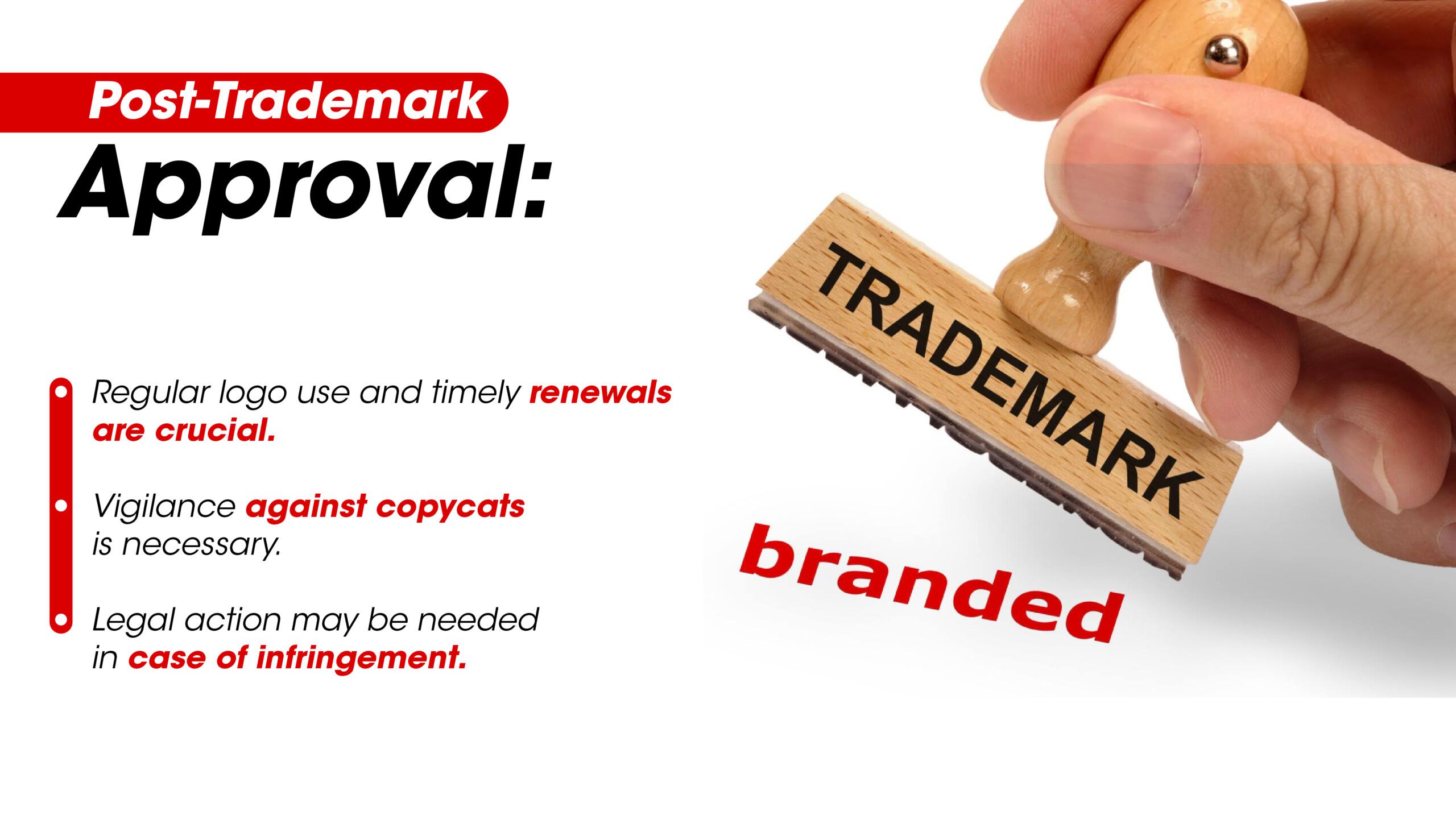
Keeping It Alive and Kicking
Once you’ve got your trademark, it’s like having a cool new pet. You need to take care of it! This means you’ve got to use it regularly in your business. If you don’t, it might be considered “abandoned.” And we don’t want that, do we?
Renewals: Don’t Forget!
Trademarks don’t last forever. Just like library books, they need to be renewed. You’ll have to file some paperwork and pay fees every few years to keep your trademark active. Ensure you mark your calendar or set a reminder to avoid any chance of forgetting!
Watching Out for Copycats
Keep an eye out for anyone who might be using a mark that’s similar to yours, especially if it’s in the same line of business. If you spot something fishy, you might need to take action to protect your trademark. It’s a bit like guarding your sandcastle at the beach!
Dealing with Infringement and Legal Challenges
Spotting Trouble
Imagine you find someone using a logo that’s super similar to yours. That’s infringement! It’s like someone crashing your birthday party uninvited. You need to decide if it’s worth taking action. Sometimes, it’s a clear-cut case. Other times, it’s a bit murky.
Sending a Friendly (or Not-So-Friendly) Note
You decide to act, you might start with a cease-and-desist letter. This letter serves as a polite request for the other party to discontinue the use of your trademark, much like saying, Excuse me that belongs to me, and please refrain from using it. Sometimes, this is enough to solve the problem.
Legal Showdown: When Things Get Serious
If the friendly (or not-so-friendly) note doesn’t work, you might have to take legal action. This means going to court to defend your trademark. It can be like a superhero showdown, where you stand up for what’s yours!
Working with Pros
Navigating trademark issues can be tricky. It’s often a good idea to work with a lawyer who knows all about trademarks. They can help you figure out the best way to protect your mark and deal with any issues that come up. So, there you have it! After you get your trademark, it’s all about taking care of it, keeping an eye out for copycats, and being ready to defend it if needed. Remember, your trademark is a valuable part of your business, so give it the attention it deserves.
Creating a Strong, Trademarkable Logo
Designing for Uniqueness and Legal Compliance
Imagine crafting a logo that’s as unique as your fingerprint. That’s what we’re aiming for! A logo that stands out in a crowd, but also plays by the rules. It’s like baking a cake that not only looks amazing but tastes great too. To do this, we need to blend creativity with a bit of legal know-how. It’s important to make sure our logo doesn’t look too similar to others, especially in our industry. This is like making sure our cake isn’t just a copycat of the one next door. Plus, we need to check that it doesn’t accidentally use protected elements – think of it as avoiding ingredients that someone else has a special recipe for.
Avoiding Common Pitfalls in Logo Creation
Now, let’s talk about what not to do. Common mistakes? Well, it’s like adding too much salt to our cake – a big no-no! One major slip-up is making a logo too complex. Remember, simplicity is key! It’s like wanting everyone to recognize your cake at a glance, even from across the room. Another pitfall is being too trendy. Sure, it’s fun to be in style, but what about next year? Our logo should be like a classic recipe – timeless and always appreciated.
The Journey of Trademarking: Case Studies and Examples
Success Stories of Trademarked Logos
Let’s get inspired! There are logos out there that have become legends – think of the swoosh of Nike or the apple of Apple. These are like the chocolate and vanilla of the logo world – classic, loved by all, and instantly recognizable. They nailed uniqueness, simplicity, and timelessness, making them superstars in the trademark universe.
Lessons from Rejected or Controversial Cases<
But hey, not all journeys are smooth. Some logos end up in hot water – like using a secret ingredient that someone else claimed. For instance, some logos get rejected because they’re too similar to existing ones, or they accidentally use a symbol that’s off-limits. Learning from these examples is like knowing which ingredients caused a cake to flop. It teaches us what to avoid and how to tweak our recipe for success.
Conclusion
Creating a strong, trademarkable logo is an art and a science. It’s about mixing uniqueness, simplicity, and a dash of legal smarts. Whether we’re baking a cake or crafting a logo, the goal is to make something memorable, delightful, and, most importantly, ours. Remember, the best logos are those that stand the test of time and become part of our lives. So, what’s your secret ingredient for a successful logo?
